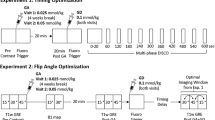Abstract
Object
To determine whether superparamagnetic iron oxide (SPIO)-enhanced magnetic resonance (MR) imaging could demonstrate signal recovery delay in irradiated areas of rat livers. We also investigated the relationship between MR imaging and histological findings.
Materials and methods
Twelve rats received 20 μmol iron/kg of SPIO followed by X-irradiation to the right upper abdomen 4 h later. Radiation doses were 0, 50 and 70 Gy. Hepatic signals were assessed on unenhanced T *2 -weighted images for up to 7 days using a 9.4-Tesla scanner. The livers were excised on day 7 and examined histologically.
Results
Normalized relative signal intensity of 70 Gy-irradiated right liver lobe (2.36 ± 0.22) and 50 Gy-irradiated right liver lobe (2.37 ± 0.46) was significantly lower than that of the non-irradiated right liver lobe (4.04 ± 0.28) on day 7, respectively (p < 0.05). Pearson product-moment correlation coefficient between relative intensity of the liver and the number of hepatic iron deposits was −0.588 (p < 0.01).
Conclusion
Superparamagnetic iron oxide-enhanced MR imaging could demonstrate signal recovery delay in irradiated areas of rat livers. It seems that the signal recovery delay in irradiated areas was due to SPIO-derived iron deposition. Hepatic signal recovery could be a novel diagnostic marker for delineation of irradiated areas.





Similar content being viewed by others
References
Clement O, Muhler A, Vexler VS, Rosenau W, Berthezene Y, Kuwatsuru R, Brasch RC (1992) Evaluation of radiation-induced liver injury with MR imaging: comparison of hepatocellular and reticuloendothelial contrast agents. Radiology 185(1):163–168
Masui T, Yan H, Kosugi I, Sakamoto S, Nishimura T, Takahashi M, Kaneko M, Fritz-Zieroth B (1996) Assessment of early radiation effects on the liver. Comparison of SPECT and MR. Acta Radiol 37(5):665–671
Morimoto N, Ebara M, Kato H, Obata T, Fujita J, Kondo F, Tsujii H, Saisho H (1999) Early detection of radiation-induced liver injury in rat by superparamagnetic iron oxide-enhanced MR imaging. J Magn Reson Imaging 9(4):573–578
Yoshioka H, Itai Y, Saida Y, Mori K, Mori H, Okumura T (2000) Superparamagnetic iron oxide-enhanced MR imaging for early and late radiation-induced hepatic injuries. Magn Reson Imaging 18(9):1079–1088
Lawaczeck R, Bauer H, Frenzel T, Hasegawa M, Ito Y, Kito K, Miwa N, Tsutsui H, Vogler H, Weinmann HJ (1997) Magnetic iron oxide particles coated with carboxydextran for parenteral administration and liver contrasting pre-clinical profile of SH U555A. Acta Radiol 38(4 Pt 1):584–597
Hamm B, Staks T, Taupitz M, Maibauer R, Speidel A, Huppertz A, Frenzel T, Lawaczeck R, Wolf KJ, Lange L (1994) Contrast-enhanced MR imaging of liver and spleen: first experience in humans with a new superparamagnetic iron oxide. J Magn Reson Imaging 4(5):659–668
Briley-Saebo KC, Johansson LO, Hustvedt SO, Haldorsen AG, Bjornerud A, Fayad ZA, Ahlstrom HK (2006) Clearance of iron oxide particles in rat liver: effect of hydrated particle size and coating material on liver metabolism. Invest Radiol 41(7):560–571
Furuta T, Yamaguchi M, Nakagami R, Akahane M, Minami M, Ohtomo K, Moriyama N, Fujii H (2013) Delayed hepatic signal recovery on ferucarbotran-enhanced magnetic resonance images: an experimental study in rat livers with gadolinium chloride-induced Kupffer cell damage. Magn Reson Mater Phy 26(3):313–324
Mitsuda M, Yamaguchi M, Nakagami R, Furuta T, Sekine N, Niitsu M, Moriyama N, Fujii H (2013) Intensity correction method customized for multi-animal abdominal MR imaging with 3T clinical scanner and multi-array coil. Magn Reson Med Sci 12(2):95–103
Hebard DW, Jackson KL, Christensen GM (1980) The chronological development of late radiation injury in the liver of the rat. Radiat Res 81(3):441–454
Mori K, Fukuda K, Asaoka H, Ueda T, Kunimatsu A, Okamoto Y, Nasu K, Fukunaga K, Morishita Y, Minami M (2009) Radiofrequency ablation of the liver: determination of ablative margin at MR imaging with impaired clearance of ferucarbotran—feasibility study. Radiology 251(2):557–565
Acknowledgments
This work was partially supported by the Health and Labour Sciences Research Grants for the Third Term Comprehensive 10-year Strategy for Cancer Control (21-5) from the Ministry of Health, Labour and Welfare in Japan, a grant from Foundation for Promotion of Cancer Research in Japan, and a grant from Japan Radiological Society. Toshihiro Furuta, MD, PhD was a recipient of a Research Resident Fellowship from the Foundation for Promotion of Cancer Research in Japan. Ryutaro Nakagami, MS is a research fellow of the Japan Society for the Promotion of Science.
Author information
Authors and Affiliations
Corresponding author
Rights and permissions
About this article
Cite this article
Furuta, T., Yamaguchi, M., Nakagami, R. et al. Delayed hepatic signal recovery on ferucarbotran-enhanced magnetic resonance images in a rat model with regional liver irradiation. Magn Reson Mater Phy 27, 501–508 (2014). https://doi.org/10.1007/s10334-014-0434-7
Received:
Revised:
Accepted:
Published:
Issue Date:
DOI: https://doi.org/10.1007/s10334-014-0434-7




